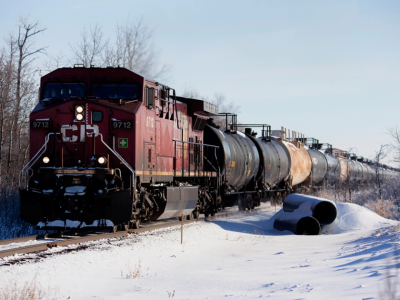Will more pipelines stop oil trains and the growing risk of derailments?

A Canadian Pacific Railway Ltd. train transporting oil leaves Hardisty, Alberta. Brett Gundlock/Bloomberg/File
This month, the Transportation Safety Board confirmed that more than one million liters of oil were spilled when an eastbound oil train tipped onto a ranch near St. Lazare, Manitoba in mid-February.
It is frequently argued in Alberta that if Canadians don’t want oil trains tipping into their streams and reservoirs, they should probably start approving some pipelines. “We can ship our energy products safely or we can ship them by rail,” wrote Alberta premier Rachel Notley in a 2018 op-ed. Sure enough, her government is now buying up rail cars to ship oil in spite of stonewalled construction on new export pipelines.
Below, a quick primer on whether pipelines really can keep oil trains off the rails.
There are more oil trains than ever before, and it’s because pipelines are full
In December, 2018 – the last month for which data is available – 1.7 billion litres of oil were exported from Canada on trains. That’s more than 23 Olympic swimming pools’ worth of oil every day, not including oil trains making their deliveries with Canada. There is now more than twice as much oil being moved on Canadian rails as at the time of the Lac-Mégantic rail disaster. The reason is simple: Alberta is producing more oil than can be moved out of the province by pipeline. In mid-2018, Alberta was producing about 4.30 million barrels of oil per day. Alberta’s existing pipelines, meanwhile, can only pump away 3.95 million barrels per day. The result was an extra 350,000 barrels of oil piling up in storage tanks every day. Just like anything else that piles up without anybody to buy it, meanwhile, the glut drove Canadian oil prices shockingly low as compared to those in the U.S. (a phenomenon referred to as “the discount”). If there’s a port or an empty pipeline nearby, shipping oil by train is too inefficient to make economic sense. But when there’s an ocean of cheap oil languishing in Northern Canada with no way to siphon it out, it suddenly makes sense to pony up the extra costs of renting a train in order to flip that cheap oil at U.S. rates.
Rail is much more prone to mishap than pipelines
Look at the carpet around any office water cooler, and you’ll likely see water stains. Not so if your office is hydrated with a water fountain connected to fixed plumbing: Without having to clunkily maneuver a 19 kg water jug into place, the chances of spillage are lessened. The same basic math holds true for moving oil: A fixed network of pipes is going to spill oil less often than a chain of wheeled tanks being pulled through the Rockies. A 2017 report by the Manhattan Institute cited U.S. accident data to determine that oil trains were three times more likely to suffer an accident than a pipeline, even if both were tasked with carrying the same amount of petroleum. A similar report by the right-leaning Fraser Institute pulled Canadian data to determine that oil-by-rail is 4.5 times more likely to go wrong than a pipeline used to carry the same volume.
Canadian trains are crashing more
Just as Canadian railroads contain more oil than ever before, the rate of crashes and derailments is on the upswing. Last year there were 1,170 major accidents on Canadian railways, a 13-per-cent increase over the average of the previous five years. The year before there were 1091 rail accidents, a 21 per cent rise over the previous year’s 900. These accident rates aren’t dramatically off the average, but Canada is nevertheless packing trains with oil cars at the same time that those trains are having trouble staying upright. In Western Canada alone the previous two months alone have seen a battery of serious incidents in sensitive wilderness areas. Three workers were killed in February when up to 60 cars plummeted off a mountain near Golden, B.C. Last week, a freight train derailed and spilled part of it load into Banff National Park. In early January, 15 cars derailed in Yoho National Park. Fortunately, in all three cases the derailments did not involve hazardous materials. Pipelines aren’t perfect; between 2016 and 2017 Canada’s 17,500 km oil pipeline network recorded six incidents in which product was released. But keep in mind that pipelines are moving 3.95 million barrels per day compared to the 350,000 barrels being moved by rail.
But when pipelines do rupture, they can spill more oil
“Over the period 1996-2007, railroads consistently spilled less crude oil per ton-mile than trucks or pipelines,” reads a 2014 report by the U.S. Congressional Research Service. The U.S. Department came to a similar conclusion in its final environmental assessment of the Keystone XL pipeline. “Rail transport has more reported releases of crude oil per ton-mile than pipeline or marine transport but, overall, pipeline transport has the highest number of barrels released per ton-mile,” it wrote. Granted, those conclusions are all based on data that preclude a massive increase in U.S. oil trains brought about by the shale oil boom. While oil-by-rail transport used to be limited to a few tankers on a mixed-car train, both Canada and the United States are now running miles-long trains that are exclusively petroleum. In 2013 alone, there was more oil spilled by U.S. railroads than in the previous 37 years. Nevertheless, even a substantial oil train is carrying a fraction of the oil carried by other means. “The total amount spilled from even a major derailment is likely to be small compared to the 260,000 barrels discharged in the 1989 grounding of the Exxon Valdez … or the approximately 40,000 barrels discharged in the largest U.S. pipeline oil spill (we) can document,” wrote the Congressional Research Service in 2014. A major point in pipelines’ favour, however, is that they have never once killed anybody, at least in Canada. Oil trains are not only at greater risk of city-gutting catastrophes like Lac-Megantic, but Canadian level crossing accidents also kill more than 100 per year.
Add more pipelines, and it will almost certainly undercut oil-by-rail
Earlier this year, the Alberta government intentionally curtailed the production of oil. The idea was to slow down the rate of oil piling up in storage tanks, and bring down prices relative to the Americans. The plan worked, and one of the immediate results was that Imperial Oil, one of the oil sands’ primary producers, had to cancel almost all of its crude-by-rail shipments. “It’s uneconomic to move crude by rail at this point in time,” said CEO Rich Kruger. Building more pipelines would have a similar effect to curtailing oil production. If all the Alberta oil can be pumped out by pipeline, its price never has a chance to drop as a result of being “stranded” in Alberta. And if prices aren’t low as compared to the U.S., it no longer profitable to use trains to get it to market. This was the conclusion of a 2017 study by the U.S. National Bureau of Economic Research. By analyzing the Dakota Access pipeline, researchers determined that if protesters had been successful in shutting it down, the only real effect would have been to prompt a boom in oil trains. “Regulatory foreclosure of pipeline investment will primarily lead to increases in rail flows rather than a decrease in overall oil production and transportation,” it read. However, all bets are off if oil prices suddenly soar through the roof. If Canada woke up tomorrow to $200/barrel oil, no amount of Trans Mountain Expansions could make it unprofitable to run oil trains.
All the pipelines in the world aren’t going to completely eliminate oil by rail
Even if Alberta was given all the oil infrastructure it could ever desire, oil trains would persist as long as the petroleum economy is around. Completion of the Trans Mountain Expansion could generally be expected to slash the number of oil trains heading over the Rockies. Similarly, Energy East could have undercut most of the oil trains heading to the Atlantic. However, rail tankers still carry the advantage that they can move faster and to more places. “The North American pipeline network is pretty big and comprehensive, but it doesn’t necessarily service all locations,” Jennifer Winter, an energy economist at the University of Calgary, told the National Post in a note. “Even if the pipeline fairy gave Alberta enough pipeline export capacity, there might still be bottlenecks in other places (in the US) which necessitates rail use.”
Source: Calgary Herald


